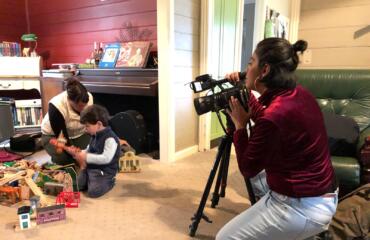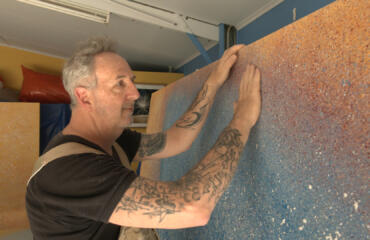Yuin artist Rheanna Lotter, 25, whose people come from the south coast of New South Wales, has seen her dot artwork in the limelight before. She’s designed Indigenous round jumpers for the GWS Giants, uniforms for the winter Australian Paralympic Team, and footy boots for AFLW star Phoebe McWilliams.
For the AFL’s Sir Doug Nicholls Round – an annual celebration of Indigenous Australia’s contribution to the game, which begins tonight with the Marngrook match between Sydney and Collingwood at the SCG – Lotter has designed handmade match-balls.
During a visit this week to the Sherrin factory in Scoresby where they were produced, Lotter said that designing the ball was “surreal” because, unlike a jumper or a pair of boots, the footy is for everyone, the central force in each and every game.

Artist Rheanna Lotter with the Sherrin footballs she designed especially for the AFL’s Sir Doug Nicholls Round
“It’s really connecting with a lot of people because everybody is using it,” she said. “It’s not just one team wearing it … everybody’s got their hands on it. It doesn’t matter who you are, you’re a part of this journey of reconciliation for us.”
The artwork on the ball (see picture) was designed by Lotter to represent the entire AFL community – from fans, to young boys and girls at grassroots level, to elite players at the peak of their careers.
Lotter said she was careful to ensure that the design captured each teams “connection with their local environment, with their fans and with their community”.
Each small grouping of dots on the balls represents one of the 18 AFL teams; the small ‘U’-like shapes in those collections represent the players of that team, sitting in a yarning circle; and the long, “journey lines” of dots that connect the groups represent the pathway from grassroots to professional football.
“It’s about coming together towards reconciliation. We’re looking after each other and taking care of each other, and connecting with each other as much as we can,” Lotter said.
The desire to combine her two main passions – art and sport – led to Lotter start her own art business in 2014.
“I grew up being very, very sporty,” she said. “And then, art was a way that I could connect to my culture … being able to have them together is why I created my business.”
Lotter chose to name her business Ngandabaa (pronounced yun-da-baa), after her grandfather, Keith Thorn. His totem was the ngandabaa (a red bellied black snake), and in his small hometown of Walgett in northern New South Wales, that was what they called him.
“I feel like we’re doing it together, even though he’s not here,” Lotter said. “When I asked him if I could name it after him, and told him it was what I wanted to do, he was so happy. He passed away a couple of years later. It’s always going to stay that [name], as a way to remember him, and to show him where his name has gone.”
She remembers the trips to Walgett to visit her grandfather, and her grandmother, Dorothy Thorn, fondly. They allowed Lotter the chance to learn her culture.
“I grew up away from my Nana and Pop, who had a lot of wisdom and knowledge about culture,” Lotter said.
They were also fun, and helped her build her relationship with her grandfather, who supported her in everything she did.

The 2019 Sir Doug Nicholls Round match balls were handmade at the Sherrin factory in Scoresby
“He was just the funniest man out there. He had jokes, and card tricks, and everybody loved him,” she said. “We’d have like, 50 of our cousins in their little three bedroom house, and it was just chaotic, and he’d make us all laugh.
“I grew up pretty fortunate. I had a roof over my house, and I had good parents that loved and supported me. I do as much as I can to give back, and I donate a lot of art to charities,” she said.
After years of trawling for work, Lotter’s profile is such that jobs now come to her. That alleviates one kind of pressure – and adds another. The painting that was long her hobby is now a source of income.
“That’s awesome that someone wants me to do it. But it comes with a lot of stress, you know? But overall, I absolutely love it,”.
All proceeds raised from sales of the red and yellow Sherrins will go to AFL Cape York house, a not-for-profit organisation that provides opportunities for young Indigenous Australians in communities across Far North Queensland.
This year’s Sir Doug Nicholls Round will specifically honour Essendon Indigenous legend Michael Long, who walked from his Melbourne home to Canberra in 2004 to meet then-Prime Minister John Howard. The pair discussed social issues that are still disproportionately affecting Indigenous lives, including high rates of suicide, incarceration, and family violence.

Lotter with Richmond’s Daniel Rioli



